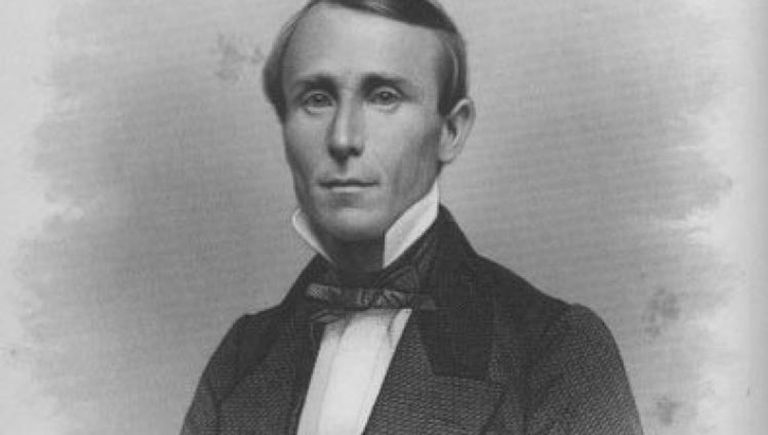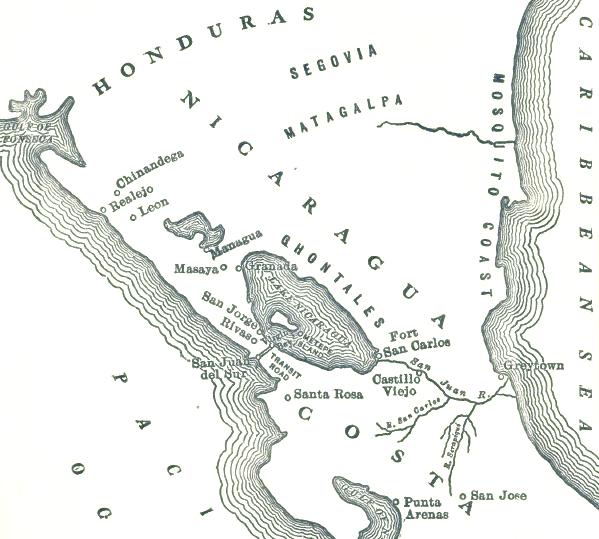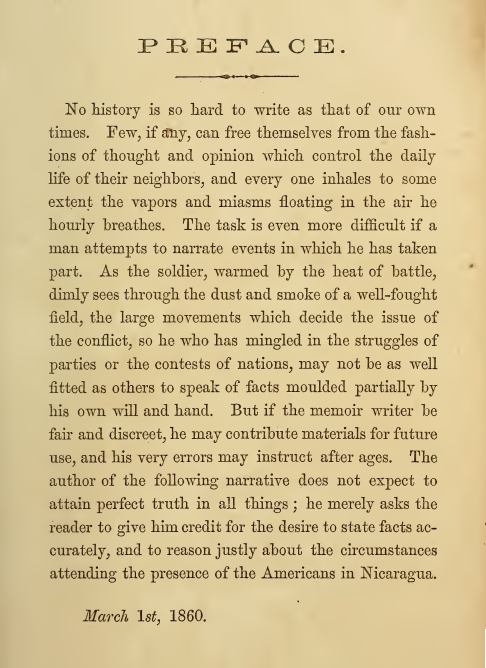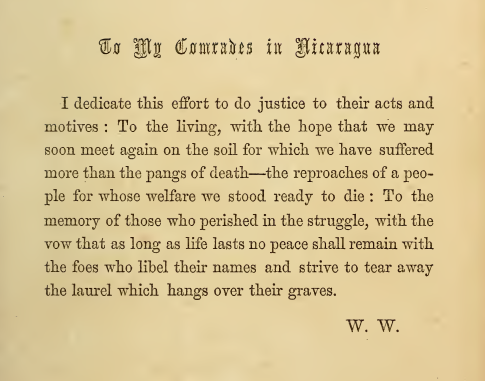
May 8, 1824 in Nashville, Tennessee – September 12, 1860 in Trujillo, Honduras, by firing squad at age 36.
By age 25, he had studied, graduated and practices medicine, studied and practiced law, and worked as a co-owner and editor of a newspaper on the East Coast before moving to California. Walker is noted to have engaged in three duels with guns, one with a notorious Wild West gunman after he insulted him in the paper he was editor of in San Francisco. During these years before beginning his enterprises in Latin America, Walker was involved in owning and running a newspaper.
In 1953, he set out to conquer lands in Latin America, first in Mexico (and took over some of sparsely-populated Baja) with 45 men, and then after retreating in fear of the Mexican government, he was tried in California for waging an illegal war but was acquitted by jury of his very popular act in 8 minutes.
In 1854, Walker went with an army to Nicaragua to aid one of the contending (and warring) political parties ("The Democrats," who were fighting "The Legitimists") as a hired army. Nicaragua had been in a civil war for decades at this time. Also notable was that Vanderbilt (the first "tycoon" of America) owned transport the San Juan river that was the main route for goods and travellers (an alternative to Panama) in the country, linking the Caribbean and the Pacific with the lake in the middle.
William Walker's book, "War in Nicaragua" written before 1860
Didn't take notes from the first 180 pages. I might go back and do that at some point.

There was a longstanding civil war in Nicaragua before Walker and his (150?) men were hired by one of the contending political parties, "The Democrats" who were the liberal party based in Leon. The Americans landed near San Juan del Sur (I think in El Gigante because they couldn't safely enter the San Juan bay). Their first fight came shortly thereafter, after a march to Rivas. After several battles, consisting of a few hundred participants each, the American and "Democratic" force defeated the force of the rival political party called "The Legitimists." Conflict continued to a degree.
Costa Rica declared war against the Americans in Nicaragua specifically. Costa Rica then caught the troops in Santa Rosa Guanacaste, unawares in an afternoon attack, and routed them. The army was depressed, many left or wanted to leave for America. Walker was preparing for a war with Costa Rica that the other three Central American states were likely to join Costa Rica against the Americans. The main strength of the army was moved to Rivas.
Although significantly dispirited, the Americans were able to add to their forces with new recruits making the passage between San Juan del Norte and San Juan del Sur (from the Caribbean to the Pacific). He added a couple of hundred that way. Also, it was proven that the large Costa Rican force was inferior to the American force combined with the ravages of disease. Various strains of Cholera were killing and laying low people everywhere in outbreaks. (The Americans had been attacked by a strain, Walker thought the probably the same strain, at Virgin Bay. He noted that "the spasms of this form of the disease are not so violent as those of the Asiatic cholera, nor does the patient sink so rapidly.) After their defeat by the Americans, the Costa Ricans (now many sick): "Its fatal effects were increased in the Costa Rican camp by the general depression of spirits which pervaded the officers as well as the men after they saw the results of the first conflict with the enemy they had come to drive, as they imagined, by easy marches, and by the mere force of their numbers, out of Central America."
At that juncture in his story, Walker comments that, "To destroy an old political organization is a comparatively easy task, and little besides force is requisite for its accomplishment; but to build up and re-constitute society -- to gather the materials from the four quarters, and construct them into an harmonious whole, fitted for the uses of a new civilization -- requires more than force, more even than genius for the work, and agents with which to complete it. Time and patience, as well as skill and labor, are needed for success; and they who undertake it, must be willing to devote a lifetime to the work."
The Provisional President moved to Leon, in large part to establish friendly relations with San Salvador (a place called "Cojutepeque" was where the San Salvador cabinet resided) but the commission to Cojutepeque was met with coldness and a statement was issued that "the presence of the Americans in Nicaragua threatened the independence of Central America." The tone was received as very insulting. But the tone of San Salvador became more peaceful when word reached them the Costa Ricans had retreated from Rivas. But soon news came that Guatemala was preparing troops to march on Nicaragua.
Walker was in Masaya when he received letters about events in Leon, where Rivas' government was. According to Walker's story, the military governor there had asked the Americans to guard an arms and ammunition storehouse, and when they were guarding it the government officials left their building hastily and rode through the streets proclaiming that the Americans were about to take Rivas prisoner and assassinate the ministers and chief men of the city. Restless locals took up arms. Rivas left the city, reportedly. The Americans prepared for a fight. Rivas was almost apprehended by American soldiers called to Leon on the road and thought the politicians making this movement was suspicious, but the American soldier in charge was counselled not to because "it would not be proper for a simple lieutenant to arrest the President and one of his Ministers." Walker left for Leon when notified. Rivas and his company were preparing to fight in Chinadega. Walker, not sure how many local leaders were going to ally with Rivas, planned to wait the arrival of his other forces and then formally march on Granada which then happened.
In Granada, Walker (at that time his title was 'general-in-chief') published a decree re-constructing the provisional government by virtue of an existing treaty that made it so naturalized Nicaraguans got equality of privileges with the native born, which President Rivas was not advocating. Walker then made a statement that he was denying the existing Provisional Government: after citing the 'unconstitutional crimes' of the government, he stated "With such accumulated crimes--conspiring against the very people it was bound to protect--the late provisional government was no longer worthy of existence. In the name of the people I have, therefore, declared its dissolution, and have organized a provisional government, until the nation exercises its natural right of electing its own rulers." Walker installed a new provisional president until the vote.
A few weeks later an election was held, "the voting was general in the Oriental and Meridional Departments" but other places didnt vote because some were controlled by Rivas (who was in Chinadega) and the Guatemalans had already entered Nicaragua in the north (the "Occidental Department"). The new provisional president declared the win for Walker, who had received "a large majority of the votes."
Walker was inaugurated on July 12, and his cabinet formed (a Minister of Relations, a Minister of War, a MInister of Hacienda and Public Credit). The government resided in Granada.
Two of the first things that happened after his inauguration. 1) A Costa Rican schooner, the San Jose, was seized in San Juan del Sur and condemned by a court for using the American flag and forfeited to the government of Nicaragua and converted into a schooner-of-war and armed with cannons. 2) he began diplomatic relations with an American Minister who had just arrived to do so (although the American government had thought Rivas was in charge when they dispatched him).
A few more arrivals of a hundred or so American men each arrived, one of them in Leon which was barricaded by Guatemalan forces.
To be continued ...

The preface to Walker's book
Cast of Characters, countries and Locations:
The National War of Nicaragua, as was called the contest between Nicaragua's two political parties in the 1800s, which were the liberal government (called "Democrats" and based in Leon, led at the time by Patricio Rivas) and the conservative government (called "the Legitimists" and based in Granada and led by ?? at the time). This contest often broke out into violence (ie civil war) in the 1840s and 1850s. It was part of this contest that the "Democrats" invited Walker to help them in 1955. Walker succeeded in defeating the conservative forces and made Patricio Rivas president. This civil war is not to be confused with the Nicaraguan civil war of 1926–1927.
Patricio Rivas, leader of the "Democrats," the liberal party in Nicaragua, based in Leon, engaged in civil war with conservative party, hired Walker and his force to defeat the conservatives party.
The Rifles - how the American forces under Walker in Nicaragua were called as a group. Walker arrived with (150?) men, but added to his forces several times as more Americans arrived, mostly in batches of a hundred or so as they crossed the San Juan Rivers between the Caribbean and the Pacific. They quickly became the most powerful (and main) military force in Nicaragua. Locals, according to Walker, were not interested in becoming soldiers for the civil war, and would rather do just about anything than fight with rifles. In this way, the American force was viewed by Walker as relieving the burden of conscripted fighting from the locals.
The Costa Ricans, the first force to enter Nicaragua (from the south) after the success of the American forces in the Nicaraguan civil war, after declaring war on Americans in Nicaragua while Rivas was still president. After initially routing the Americans in a surprise attack, their much larger force (over 1000? men), many of them having been infected with Cholera while in Nicaragua, fled after defeats by the American force. At the time, Costa Rica was led by President Juan Rafael Mora.
The Guatemalans, the second force to enter Nicaragua (from the north) to attack the Americans, who by then had elected Walker as president. At the time, Guatemala was led by President José Rafael Carrera Turcios (Rafael Carrera).
Contextual events of the era: Caste War of the Yucatan, American Civil War, liberals attempts to overthrow the Catholic Church and aristocrats power, Mexico Wars, boundary dispute between Belize and England, caudillos.
Previous to the Nicaraguan Civil War: Following the period of dramatic discovery and exploration in the New World in the first decades of the 1500s, the period of conquest began. In 1538, Spain created in its new territory the "Viceroyalty of New Spain" which included all of what is now Mexico and Central America except Panama. In 1570 this political entity was split and the southern half called the "Captaincy General of Guatemala." The land now known as Nicaragua belonged to this, and was at the time a group of administrative regions with its capital in Leon. (It was in 1610 that this "old" Leon was destroyed by the eruption of the volcano Momotombo, and afterwards Leon was reconstructed north of the original site). Between 1570 and 1821, the region had minor civil wars and rebellions which were subdued easily by the Spanish government there, as well as being the days of pirate raids, of which there were lots. Then in 1821 the land changed politically, first becoming part of the First Mexican Empire that year, then in 1823 part of the United Provinces of Central America, and in 1838 it became the independent republic of Nicaragua. From this point the rivalry between the two political parties in the country lead us to our subject with Walker.
The east of the country, the Caribean Coast or "Mosquito Cost" based on the town of Bluefields, has a separate political history from the western side of the land. Even today most of what happens in Nicaragua is all on the west side, where the biggest cities (and now the Pan American Highway, opened officially in 1963) are, not only in Nicaragua but in Costa Rica to the south and El Salvador and Honduras to the north as well. There is a large space of mostly uninhabited land between this populated part and the Caribbean Coast. The Mosquito Coast was claimed by the UK between 1655 and 1838, then was designated to Honduras in 1859 and transferred to Nicaragua in 1860. But even after becoming part of Nicaragua in 1860 is remained autonomous until 1894. The Caribbean side doesn't feature much in our story, taking place around 1855: However, San Juan del Norte, the Caribbean end of the San Juan Rivers route between the two oceans, is in the south of Nicaragua on the Caribbean side.

The dedication in his book
Comments: 0